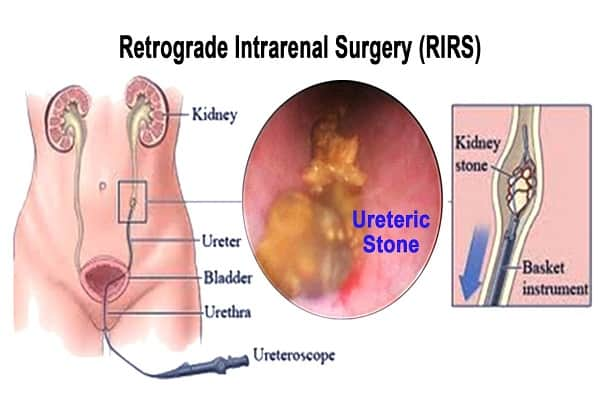Flexible Ureterorenoscopy (RIRS) For Complex Calculi In Lucknow
- Home
- Services
- Endourology
- Flexible Ureterorenoscopy (RIRS) For Complex Calculi
What Is Retrograde Intrarenal Surgery (RIRS)?
Retrograde Intrarenal Surgery techniques are remarkable. It is performed by a qualified urologist in Lucknow by passing the endoscope through the urethra into the bladder and through the urethra into the collecting drainage system of the kidney. This avoids resorting to major operations of cutting open the body or even puncturing the kidney. This is a day-care surgical procedure done inside the kidney with a thin (2-3mm) flexible viewing tube better known as a flexible ureterorenoscope (FURS). Due to recent technological strides in this field, it has become possible to implement Retrograde Intrarenal Surgery (RIRS) to manage kidney stones and small tumors. Typically laser energy is used to dust the stones (or burn the tumor as the case may be). Very fine (less than 1 mm in diameter) forceps are available to pick up stone fragments or tumors.

How is the surgery performed?
Before procedure :Preoperative checkups are done to ascertain the position of the stone, the function of the kidney, reasons for forming stones, the presence of infection, the general health condition of the patient, and fitness for anesthesia. Typically a battery of laboratory tests (blood and urine) and radiology tests (either x-ray with ultrasound or a CT scan of kidney-ureter-bladder region, x-ray of chest, and if indicated ECG, chest x-ray, echocardiography) are performed before consulting anesthesiologist. Once all the tests and consultations confirm fitness for the procedures, the patient is typically admitted on the day of surgery (or the evening prior) and is made to fast for 4-6 hours before the surgery.
The Surgery: In the operation theater, firstly the patient is put under anesthesia [either fully asleep (general anesthesia) or lower body numb (spinal anesthesia)]. The patient is positioned in a lithotomy position, a position in which women give birth. An antibiotic is given through intravenous injection. After surgically cleaning the private parts, the flexible URS is passed under camera vision from urine passage via the bladder and ureter into the kidney. The stone (or tumor) is visualized and then precisely dusted with a holmium laser which is delivered through a very thin wire, called fiber (0.2 – 0.3mm in dia). At the end of the procedure a thin long polymer tube, called a double J stent, is left inside the urinary system (from kidney to bladder); it is typically removed in 2-4 weeks by a small endoscopic procedure cystoscopy. Unlike stents for heart attacks, this is a temporary tube to assist in healing and comfort to the patient and must be removed in the stipulated time decided by the doctor.
The ureteroscope can easily remove kidney stones of up to 20mm in size; in expert hands, even larger stones can be treated thus avoiding bigger surgical procedures (like PCNL which entails puncturing the kidney). However, for treating larger stones, the procedure may have to be repeated several days apart.
Post-surgery: After completing RIRS, the patient will be taken to the recovery room where he will be monitored for vitals, pain, and side effects, if any. A urinary catheter may be placed into the urethra for a few hours for continuous drainage of urine. The patient may be discharged the same day (after at least 6-8 hours of observation) or the next day as per patient comfort and clinically suitable. Typically patient is advised to take a few medications for pain and discomfort and plenty of liquids (3-4 liters a day). Generally, antibiotics are not prescribed beyond 24 hours. He/she is advised to return in 5-7 days after surgery to check for general health and the presence of infection.
